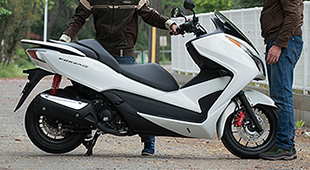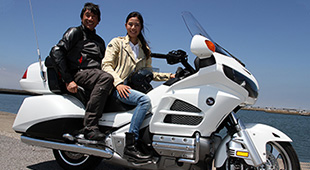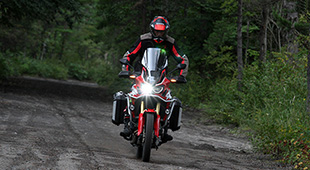Tech Views — Vol.8 CRF1000L Africa Twin
Development Story (4/5)
A Big Touring Bike
With Stronger Off-Road Performance
"That's when I rode it for the first time. It was still a prototype, and though I wasn't a member of the development team, I was asked to give it a ride and provide some commentary. My honest, immediate reaction was that what they were making was not what they set out to create."
This is Tetsuya Kudō, who in years past had taken charge of the development of such legendary Honda motorcycles as the RC30, the NR750, the CB1300 series and the CB1100 at Honda's Motorcycle R&D Center. Kudō is not only an engineer who has designed many well-known motorcycles, he is also an avid motorcycle rider who loves touring with his own 250cc off-road bike. Naturally, his opinions tend to be insightful.
Kudō — "I knew that their team was developing the new Africa Twin. However, when I rode the prototype, what I actually felt was vastly different from what I had heard and expected. It hardly seemed to stray very far from the touring bike category, or at least I didn't feel any of the off-road performance they were telling me about. 'What on earth are they trying to achieve here? This isn't the bike they're aiming for, is it?' Its shape was nearly complete, but its contents were still a long way away from their original image."
Kudō conducted several test rides of both the original Africa Twin and rival models in the Adventure class, and took them touring over and over again. In fact, for a few months he rode them almost every weekend. Soon thereafter, Kudō also officially joined the development team as its overall coor-dinator in order to guide the direction of development and give the new machine some 'flavor' in its final stages.

Kudō — "Anyway, I thought I'd try to 'season' the bike's off-road performance. This is usually a matter of seasoning the engine, but first I wanted a lot more of the feeling of the tires gripping the ground, and intensely concentrated on that one point. In my view, this machine's virtual rival would be a 250cc class bike. The ability to, on a whim, cut off onto a dirt side road you spot while touring on a national highway can be achieved by seasoning the engine or using the chassis' controllability, because that was certainly possible with the original Africa Twin."
As he repeated the process of giving the engine more 'flavor,' reviewing the chassis and resetting the suspension over and over again, Kudō gradually began to sense that the new Africa Twin was finally starting to take shape from its first prototype.
Kudō — "Since the specifications of the first selected engine and chassis were so good to begin with, they could be increasingly improved through repeated seasoning. In particular, I felt that the new DCT (Dual Clutch Transmission) could give it some extra unexpected appeal. Even I was able to do things on this bike that I'd never experienced before."
DCT is a technology of which Honda is most proud. Of course, one aspect is that it makes riding easy, as one would want in touring performance, but its characteristics were retuned to best fit the new Africa Twin as an effective mechanism for enhancing off-road performance.
Kudō — "For example, when venturing off road, sometimes the ground is more rugged and uneven than expected, or big holes continually turn up. At such times this usually requires a precise combination of throttle and clutch work while shifting up and down through the gears, and body control to keep your balance in low gear. In these situations, the DCT proved to be surprisingly effective. It allows the bike to run smoothly and easily, and is especially effective when traveling slowly at low speeds. Wanting a more solid feel of the tires gripping the road surface in such cases, I flipped on the G switch*."
* The G switch is a new function added to the DCT that gives the clutch more capacity to control the engine's torque. It can better transmit that torque to instantly enable the rear tire to grip the road surface. Leaving the switch off makes it possible to respond to such conditions much like gently letting out the clutch at low revs.
The new Africa Twin was moving toward completion at last. However, reality waits for no one. Counting back from the announced release date set when model development began, very little time remained.
"I joined the development team around that time. It was a stage at which development was proceeding, but much more needed to be done, including the actual production in preparation for sales. I already knew what they were doing, and therefore my role was to closely keep an eye on the reality of the situation by getting favorite aspects and desires into shape," says Naoshi Iizuka who served as a Project Leader. Iizuka, who is a contemporary of Kudō's at Honda, is also an expert engineer and has handled many of the company's best-known machines of years past, as Kudō has. It becomes Iizuka's duty to get the project into gear.
"Since I joined the team, I've worked almost every day without taking any days off."
Iizuka smiles,
"Every day has been non-stop rushing about the whole time."
Development continued forward toward the final stage.
- Top
- History
- A New Era
- Technical Points
- Development Story









